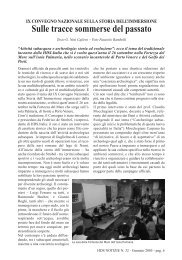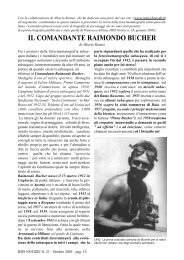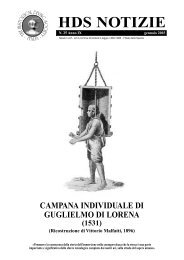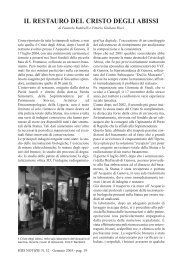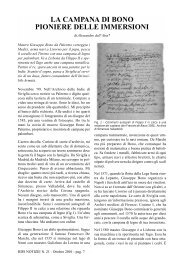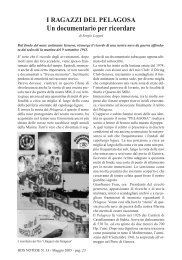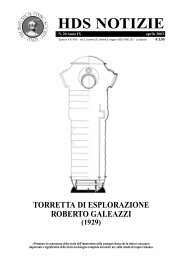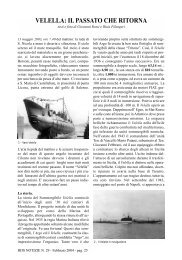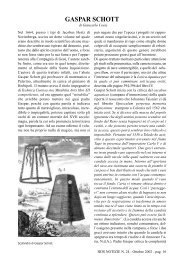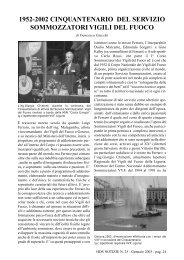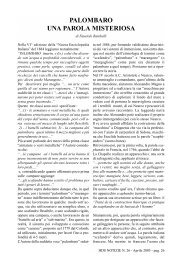Leggi l'intero numero - Historical Diving Society Italia
Leggi l'intero numero - Historical Diving Society Italia
Leggi l'intero numero - Historical Diving Society Italia
You also want an ePaper? Increase the reach of your titles
YUMPU automatically turns print PDFs into web optimized ePapers that Google loves.
invenzione…” e Gianni Roghi a pagina 31 nel<br />
suo “Caccia Subacquea” “…Già conosciuta dai<br />
pescatori di perle, la maschera è stata inventata e<br />
brevettata nella sua forma moderna col nome di<br />
Monogoggle dai francesi Wilhem e Kramarenko<br />
nel 1937, ed ha fatto la sua comparsa in <strong>Italia</strong> nel<br />
’38 …”<br />
Infatti in quell’anno, Malagamba di Genova,<br />
dopo aver assistito ad una battuta di caccia subacquea<br />
all’isola di Bergeggi, firmò un accordo<br />
commerciale con Whilem e Kramarenco per la<br />
vendita in <strong>Italia</strong> della maschera Monogoggle e<br />
del loro fucile subacqueo.<br />
La Monogoggle non copriva il naso ed in<br />
immersione si inchiodava alla faccia con conseguente<br />
effetto ventosa sugli occhi in risalita.<br />
Kramarenko per ovviare allo schiacciamento<br />
sugli occhi della Monogoggle applica ai due lati<br />
della maschera, come già aveva fatto Poulvenis,<br />
due perette di gomma che in immersione immettono<br />
la loro aria nella maschera (fig.14).<br />
L’inconveniente della Monogoggle fu eliminato<br />
da Maxine Forjod nel 1938, che brevettò una<br />
maschera che copriva anche il naso.<br />
Dopo questo periodo si entra nella storia, diciamo,<br />
contemporanea. Le pinne diventano pian<br />
piano di uso corrente, gli occhiali non vengono<br />
più utilizzati per l’immersione e le maschere,<br />
che qualcuno comincia a produrre in modo industriale,<br />
assumono le forme più diverse, ma sempre<br />
nell’insieme occhi-naso oppure coprenti<br />
tutto il volto, con un unico vetro rotondo o sagomato.<br />
L’innovazione che ha poi cambiato la concezione<br />
di maschera , come tutti sappiamo, è<br />
apportata da Egidio Cressi con la “Pinocchio”<br />
nel 1954-56.<br />
Note<br />
1 – Il “ Musèe du Scaphandre” a Espalion, in Francia, possiede<br />
un “regolatore di pressione” con semielmo originali<br />
Rouquayrol-Denayrouze che sono stati restaurati e tuttora<br />
utilizzati per immersioni dimostrative.<br />
2 – Una replica di questi progetti di Leonardo (pinne per<br />
le mani e scafandro con manichetta per la respirazione)<br />
sono esposti al Museo della Scienza e della Tecnica<br />
“Leonardo da Vinci” di Milano.<br />
3 – Mario Baratta, autore di “Curiosità vinciane “, edito<br />
nel 1905 dai Fratelli Bocca di Torino, analizza nella<br />
prima parte del libro la scrittura e gli enigmi di Leonardo<br />
e nella seconda parte, quelle che sono state le sue intuizioni<br />
“…nella invenzione dei palombari e degli apparecchi<br />
di salvataggio marittimo”. Completa poi il tutto con la<br />
HDS NOTIZIE N. 28 - Novembre 2003 - pag. 21<br />
mask. More Kramarenko took a mould of his face,<br />
in order to adapt the contraption to his contours…<br />
and … in 1937 he puts on the market his invention…”and<br />
Gianni Roghi in page 31 of “Caccia<br />
Subacquea” “…Already known by the pearl<br />
anglers, the mask was invented and patented in<br />
her modern form with the name Monogoggle by<br />
the French Wilhem and Kramarenko in 1937, and<br />
it appeared in Italy in 1938…”<br />
As a matter of fact during that year, Malagamba<br />
of Genoa, after having attended an underwater<br />
hunting beating in the island of Bergeggi, signed<br />
a commercial agreement with Whilem and<br />
Kramarenco for selling in Italy the Monogoggle<br />
mask and their underwater gun.<br />
The Monogoggle was not covering the nose and<br />
during the dive was getting nailed down to the<br />
face with the consequent sucker effect on the<br />
eyes during ascent. Kramarenko in order to<br />
obviate to the squeeze on the eyes by the<br />
Monogoggle applies on the two sides of the<br />
mask two-rubber little enemas as Poulvenis did<br />
already, that during the dive introduce their air<br />
into the mask (fig. 14).<br />
Maxine Forjod, who patented the mask that was<br />
covering the nose as well, eliminated in 1938 the<br />
inconvenience of the Monogoggle.<br />
After this period we are entering in the let say<br />
contemporaneous history. The fins slowly<br />
become of everyday use, the goggles are not<br />
used for diving any longer and the masks, that<br />
somebody starts to industrially produce, take all<br />
different shapes, but always eyes-nose on the<br />
whole or covering the whole face, with only one<br />
round or shaped glass. Egidio Cressi brought the<br />
innovation that after changed the idea of mask,<br />
as we all know, with the mask “Pinocchio” in<br />
1954-56.<br />
Notes<br />
1 – The “ Musèe du Scaphandre” in Espalion, France,<br />
owns an original Rouquayrol-Denayrouze “pressure regulator”<br />
with half-helmet, that has been restored and it is still<br />
used for demonstrative dives.<br />
2 – A replica of this Leonardo projects (fins for hands and<br />
diving suit with breathing hose is displayed in the<br />
“Leonardo da Vinci” Science and Technology in Milan.<br />
3 – Mario Baratta, author of “Curiosità vinciane “, edited<br />
in 1905 by Fratelli Bocca in Turin, analyses in the first<br />
part of his book the writing and the enigmas of Leonardo<br />
and in the second part what have been his intuitions “…in<br />
inventing the hardhat divers and the devices for the maritime<br />
rescue”. He then complete the whole with the first



